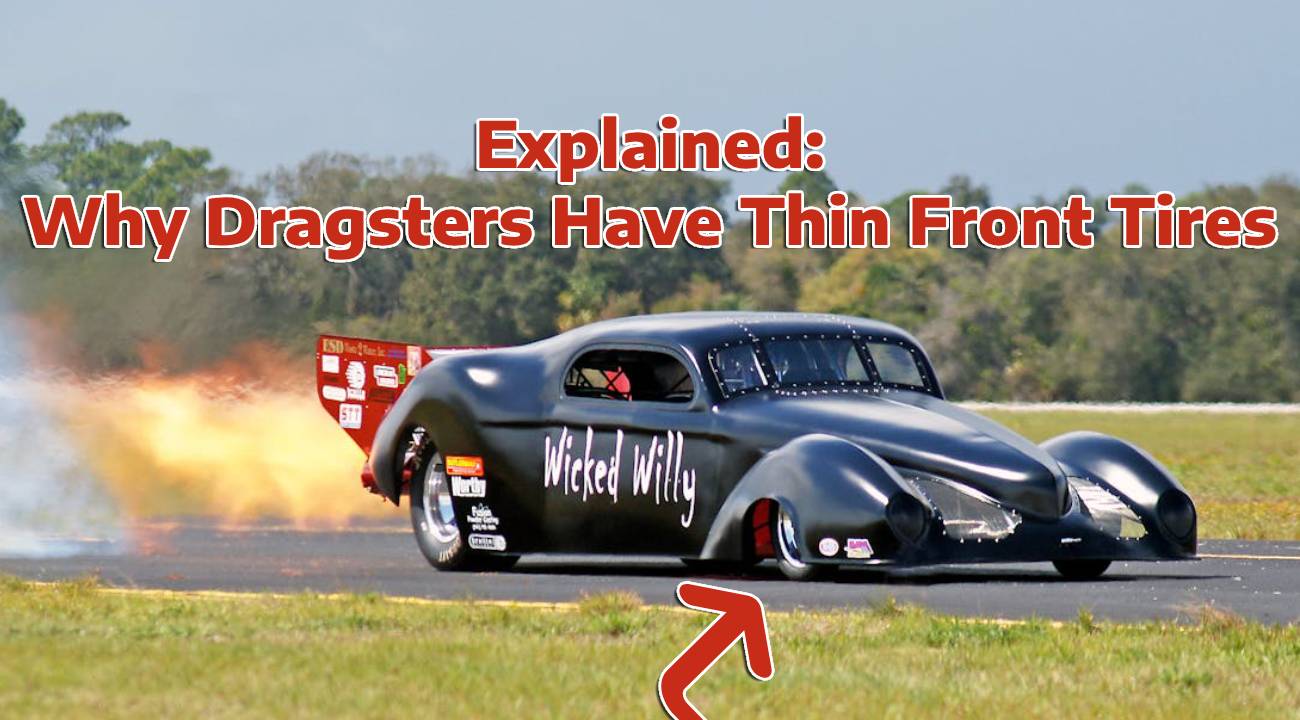When it comes to drag racing, every detail of a car’s design serves an important purpose. This includes the choice of skinny front tires. While they may seem like an aesthetic decision, these narrow tires help in reducing rolling resistance, a force that occurs when tires deform as they roll, directly impacting the vehicle’s acceleration and speed. They reduce rolling friction because they have a smaller contact area with the road, meaning less surface area is deformed as the tire rolls. Less deformation means less friction, which allows the car to accelerate more efficiently.
Tire pressure can also affect rolling friction. This is why skinny front tires in drag racing are often inflated to higher pressures than the rear tires. While the wider rear tires maximize traction at launch, skinny front tires help reduce air resistance, allowing for more efficient acceleration and better straight-line stability. A combination of these factors results in improved acceleration and enhanced track performance.
The Role of Wider Back Tires and the Aerodynamics of Skinny Front Tires
Wider tires at the rear provide the necessary traction to handle the immense power of drag cars. Using wide tires at the front would increase friction and resistance. This would slow the vehicle down. Several skinny tire options allow drag racers to optimize their setup and up their performance. For instance, tires like the Mickey Thompson Sportsman SR are designed specifically for drag racing.. These tires have a lightweight build and are optimized to reduce rolling resistance. For cars that are pushing extreme horsepower, this seemingly small change can make a noticeable difference on the timesheet.
A car’s aerodynamics are another important part of drag racing as they relate to how efficiently the car moves through the air. This is where the drag coefficient comes into play, which measures how well a vehicle cuts through the surrounding air. For example, a standard race Miata has a drag coefficient of 0.48 with a splitter and a wing, while a Formula 1 car’s drag coefficient ranges between 0.7 and 1.1, depending on its design.
In this regard, skinny tires help improve a car’s aerodynamic profile as they reduce the frontal area. This minimizes the air turbulence at the front and allows the car to cut through the air more efficiently, especially at high speeds. On the other hand, wide tires tend to create larger air pockets that increase air resistance. However, while this smaller front area does reduce some drag, the overall impact on the car’s total drag is relatively small. The majority of drag at high speeds comes from the car’s body shape and other factors. So, choosing the right racing cars should be your first priority.
ALSO, CHECK OUT: Skoda Enyaq RS Race Concept: A Lighter, Faster EV Ready for the Track
Weight Reduction and Optimized Traction Distribution
Shedding some pounds can improve speed. This is why lighter race car often has a significant advantage. For example, the Ford Mustang GTD achieves its impressive 202-mph top speed because it adopts lightweight design principles inspired by the GT3 race car. It utilizes extensive carbon fiber body panels and focuses on weight reduction in nearly every component. In drag racing, skinny tires reduce overall weight. This decrease improves the car’s power-to-weight ratio, which reduces acceleration times. With less weight to push forward, the engine can achieve higher speeds quickly, giving drivers a competitive edge off the starting line. The light nature of the skinny tires also reduces the load borne by the suspension and drivetrain, allowing for a more efficient power transfer from the engine to the wheels.
One of the primary reasons skinny tires dominate the front of drag racing cars is because of they help optimize traction distribution. During a drag race, most of the vehicle’s weight shifts to the rear axles due to the force of the acceleration. The weight transfer maximizes the grip on the rear tires. The front tires experience minimal load during this process. And, with less weight to manage, the skinny tires are sufficient for maintaining directional control. This way, the car’s power is effectively distributed on the rear tires, where it matters most.
ALSO, CHECK OUT: 2025 McLaren Artura vs 2025 Chevrolet Corvette E-Ray: Hybrid Supercar Comparison
Case Study: The Top Fuel Dragster
Top Fuel Dragsters are the fastest class of drag racing vehicles and a perfect example of why skinny front tires matter. These cars generate over 11,000 horsepower and reach speeds exceeding 330 mph in less than 4 seconds.
To handle such extreme power, they rely on massive rear slicks for maximum traction. On the front, you’ll find ultra-skinny tires mounted on lightweight wheels. These tires aren’t designed for grip but for reducing drag. Top fuel dragsters often use tires just 4 inches wide, optimized for stability at high speeds while ensuring that all the engine’s power pushes the car forward without unnecessary drag.





Leave a Reply